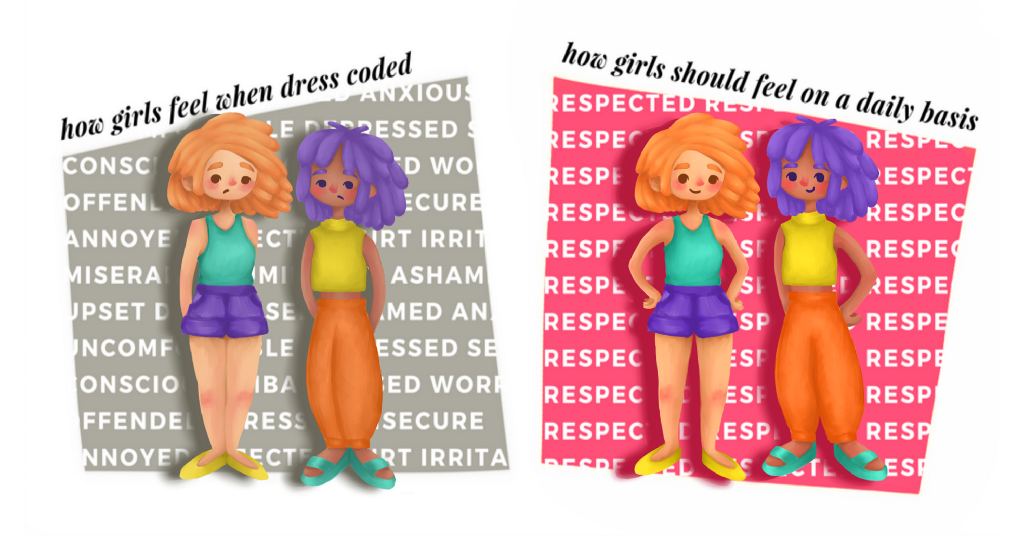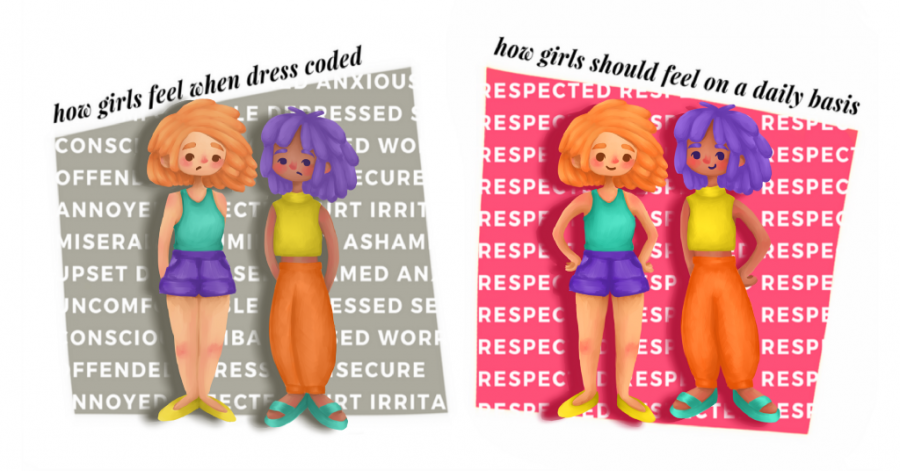Students call for dress code clarification
June 6, 2018

O n a rare, sunny San Francisco day in the fall of 2016, Erika Dorwart, a sophomore at the time, decided to wear denim shorts to school. Walking down the second floor hallway of Lowell High School, a security guard stopped Dorwart and told her to change out of her shorts, arguing they were too short to wear on campus. Feeling embarrassed and confused, Dorwart reluctantly changed into sweatpants.
Many students experience occurrences like Dorwart’s due to the enforcement of school dress codes that can seem unfair or discriminatory.
The dress code outlined in the SFUSD Student and Family Handbook (page 57) applies to all the schools within the San Francisco Unified School District from kindergarten to 12th grade and attempts to regulate how students dress and create a standard for what is appropriate. Some clothing choices considered inappropriate are garments where the torso is exposed, garments where the entire thigh is exposed, bathing suits or cut-offs, sagging pants, clothing with obscenities or suggestive material, and tobacco or controlled substance promoting items. In 2014, the San Francisco Board of Education updated the dress code to remove any district-wide regulation of hats, caps and head coverings, lifting the hat ban. This update also encourages schools to develop their own dress codes, requires consistent enforcement of that dress code, and for families and students to be informed of their school’s guidelines. Although some people argue that school dress codes are beneficial and useful tools in protecting students from harm, many argue that school dress codes can be discriminatory towards females, unfair, and vague. Some solutions that have been offered up are making dress codes less restrictive or removing them completely, while others feel they should be left as/is.
“Actually, I have no idea what our dress code says.”
Because the SFUSD policy is somewhat vague, stating that the school should intervene if a student’s clothing is “extreme and could cause school distraction or disruption or be unsafe,” reporting a possible dress code infringement to the appropriate administrator is left to the students, teachers, administrators, and other adults at the school. One of the administrators at Lowell in charge of dress code citations is Dean Ivan Yee. On the process of being dress coded at Lowell, Yee said, “Hopefully any adult that has the wherewithal would help out and talk to students. If they don’t, then they report it or security sees them or whoever brings them in to whoever’s appropriate, [or] whoever’s available to talk to them. It’s not always me, sometimes it’s counselors, sometimes it’s different people.” Yee believes that students are typically reported if their clothing is offensive or distracting. When asked what type of clothing could be distracting, Yee replied, “If shorts are too short, stuff like that,” and that students “should know what too short means. When you’re showing too much.”
Expecting students to know what is inappropriate clothing without clearly stating it in their guidelines is one of the key issues with the SFUSD dress code. Although the update in 2014 “requires that staff enforce their new dress codes in a consistent manner, and that information about each school’s dress code be disseminated to all students and families,” there is still confusion around the dress code. “Actually, I have no idea what our dress code says,” Sophia Young, a senior at Lowell, said. While the dress code gives many examples on what is considered inappropriate, many students feel they are not descriptive enough. According to a survey done by The Lowell, students shown images of four shorts of different lengths had varying responses on which they considered short shorts. This inspecificity leads to lack of understanding among students which begs the question: How are students supposed to abide by rules that do not exist? However, others, like Yee, believe that students should be able to determine if their choice of clothing is appropriate or inappropriate in the school setting.
“[Students] should know what too short means. When you’re showing too much.”
Another point of contention facing dress codes is whether or not they are discriminatory towards females. In a separate survey, 80 percent of Lowell students believe that the SFUSD dress code discriminates against female students. Despite remaining gender neutral, many of the clothing items listed as inappropriate in the handbook, such as tube tops, half tops, halters, micro minis, and short shorts, are stereotypically worn by females. And even if the guidelines are not inherently sexist, according to Dorwart, society has been bred to limit what women can and cannot wear and by leaving it up to the schools to decide what is acceptable, female students tend to be subject to more scrutiny at the hands of administrators, teachers, and even their peers. “Dress codes are usually sexist,” Young, said. “For guys it’s only, like, [you] can’t be shirtless, and that’s it, and girls it’s like you have to have a certain length of shorts and your shirt can’t be to short or you can’t have lots of cleavage and I think it’s unfair.”
Many believe that the basis of the dress code, that students should not be wearing clothes that are distracting, disruptive, or unsafe, is what leads to discrimination towards female students. An article published in USA Today says that, “the message the dress code sends to girls is: Your body is a problem. Don’t distract the boys.” According to Dorwart, it is unfair to dress code female students for ‘distracting’ or ‘disruptive’ clothing. “I don’t see how it’s distracting towards boys,” Dorwart said. “If they are distracted it’s their own fault, so I don’t think girls should be blamed for what they wear because it’s our choice, our own bodies.”
“Dress codes are usually sexist”
Despite opposition from students, in a National Post article, administrators say dress code standards have a valid purpose and are needed to ensure the safety of students. In an attempt to attain this safety in his classroom, John Raya, a language teacher at Lowell, said in his syllabus, “Be careful about wearing clothing that is too revealing, like short shorts and micro minis. It could set you up as a target for sexual harassment.” Although his intentions were good, Raya’s comments frustrated many students. One, who wishes to remain anonymous, said, “Saying that wearing ‘shorty shorts’ may make someone a target for sexual harassment only encourages the stigma that the victim is to blame because of what they were wearing and that’s just so fucked up.”

While some, like Yee, believe that the SFUSD dress code should be left as is, many, who feel the dress code is discriminatory and ambiguous, want to see it changed. In a survey of Lowell students, 66.7 percent said that the school dress code should be made less restrictive and 13.3 percent said they want to see it removed completely. Young said, “I don’t think there should necessarily be a dress code,” and that, “women should be able to dress however they feel comfortable and they shouldn’t be shamed for it or reprimanded.” The Board of Education currently has no plans on changing or updating the dress code in the near future, but schools are encouraged “to develop their dress codes in an inclusive manner, with the input of students, staff and the community,” as part of the 2014 update.
As for Dorwart, she thinks that students should, “be free to wear what they feel comfortable in and in whichever way they want to express themselves,” and says she is going to do just that, despite the dress codes limitations.



Hayliana Howes • Dec 3, 2018 at 6:21 pm
I have to write a proposing a solution paper for my Composition 101 class, though I am still a junior in high school. My school has a very strict dress code that all of the three high schools in our district are supposed to enforce, yet my school is still the only one doing so. I am trying to push for a revision of the dress code to reflect modern changes in fashion (i.e leggings, crop tops, ripped jeans, etc.) I have already conducted a local survey of some classmates and teachers, but I don’t know where to go from there. This is a big deal to me, and I know that I am being a voice for thousands of students in my school district that feel the same way I do, but are just afraid to speak their mind, or don’t know how to make change happen. So I need help in figuring out where to go from here.
thanks, Hayliana